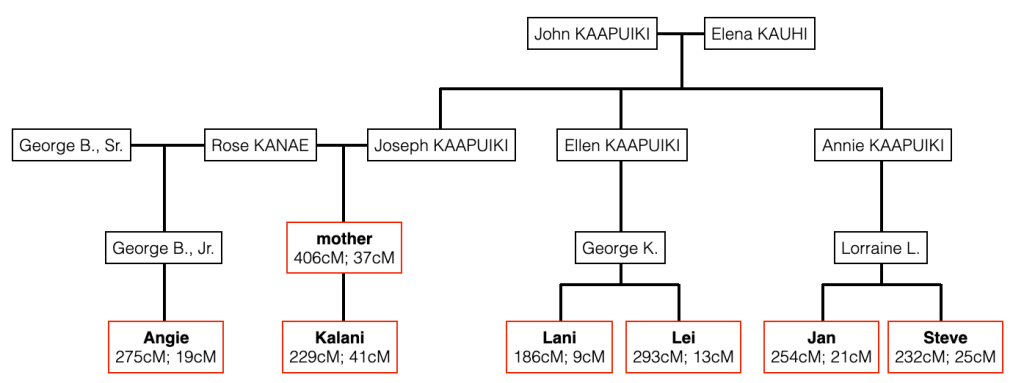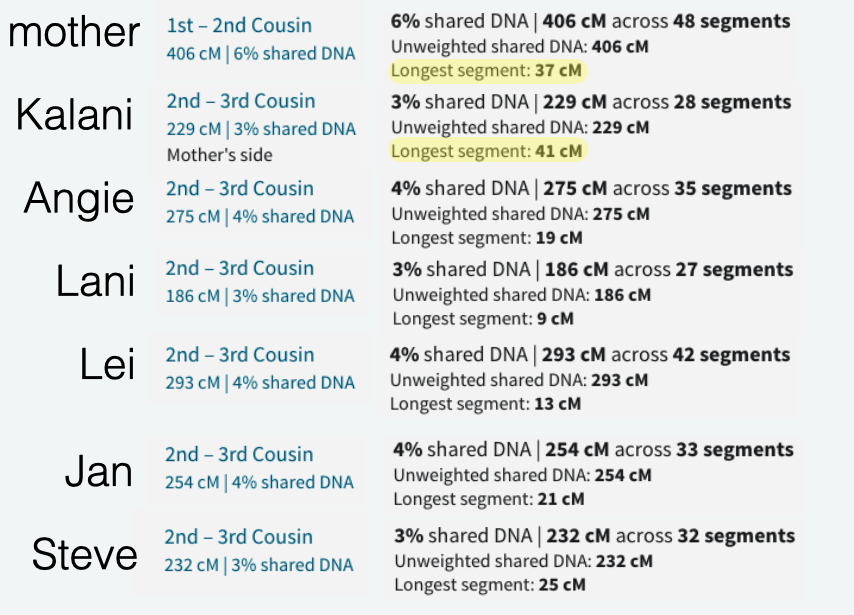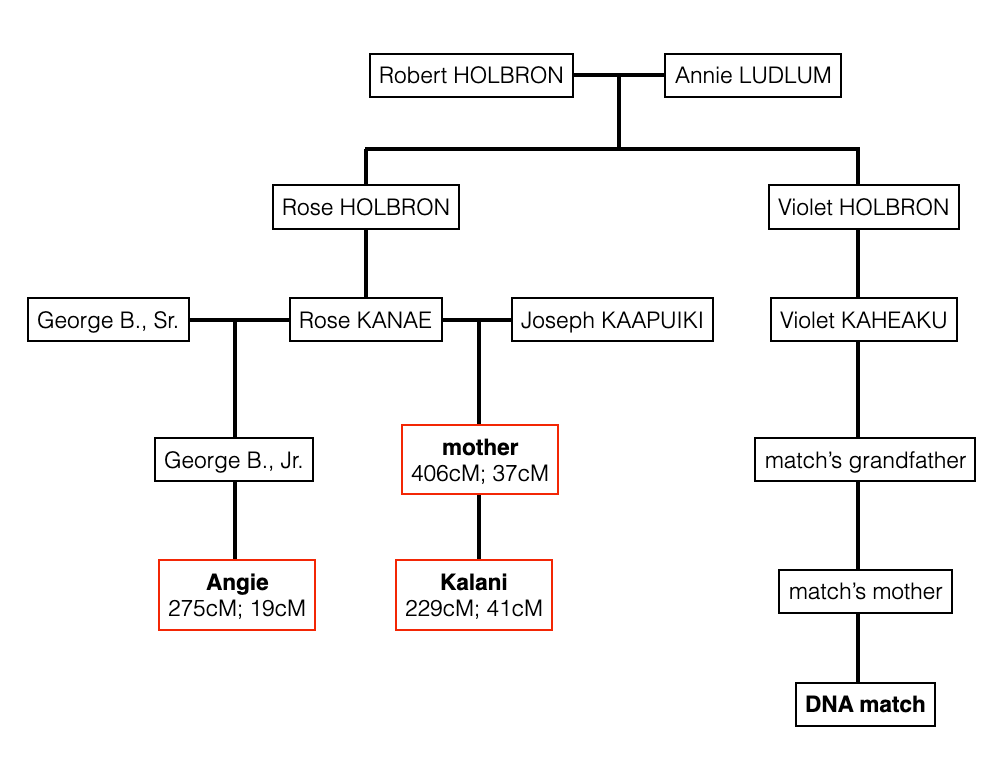On December 29, 2021 while going through my new matches at AncestryDNA, I decided to go through my closest matches to be sure I didn’t miss anyone. Usually, these closer matches are endogamous, mostly New Zealand Maoris.
While going through my list of top matches, I noticed a match that I haven’t viewed and had a Japanese surname, which to me would indicate that the match has ties to Hawai’i. And I was right, but more surprisingly, he shared a fairly large segment with me – 41cM. The person had no tree, so I immediately contacted him identifying my maternal grandparents and their parents. Right after that I began to search everything I could and managed to only find the names of his parents, as all three of these people (including the match) were star athletes, so their names came up often in the newspaper. I couldn’t find anything else other than their accomplishments and winnings.
The usual process that I do to figure out how a DNA match is connected is to compare with other relatives and to see which one of these relatives shares a large segment, at least 30cM. This would indicate a non-endogamous match, or rather it is more likely to be a true 2nd – 3rd cousin match. Since I have access to these relatives’ accounts, I can see how large of a segment they share. Using the “Shared Matches” feature is not useful when dealing with Polynesian matches as we tend to match everyone.
The cousins whose account I have access to are in bold. (These are not their real names)

So I go through my list of matches, and usually I can figure it out with the longest segment size to which branch the match belongs. But that may not be as effective once you get into the 3rd cousin range. In fact, while Jan, Steve, Lani and Lei are all my 2nd cousins, Jan and I share a longest segment size of 24cM while the others exceed 30cM. This is why I have been pushing the 30cM longest segment size, although sometimes, as the exception with me and Jan, it may not be as large. But with Jan compared to Lani and Lei (her 2nd cousins) and with her brother Steve compared to Lani and Lei, and when I compare myself to Lani and Lei, we do all share a longest segment size that is more than 30cM.
But this is what it looked like for all of us when I compared the longest segment size.

So while Steve had the next highest (after me & my mother) longest segment size, it wasn’t enough to convince me that the match was on my grandfather’s side. And while I usually ignore the total shared amount of DNA when trying to narrow down to which branch (my grandfather’s paternal vs. maternal side or my grandmother’s paternal vs. maternal side) that match belongs, you can see that compared to my 2nd cousins Lani, Lei, Jan and Steve, only Lani shares less total shared DNA with this new DNA match than I do. But my other 2nd cousins including my 1/2 1st cousin Angies shares more DNA than I do.
Days later I looked into the match again. And not with my other DNA matches as I’ve exhausted all avenues on the DNA aspect and matching, but rather searching for my match’s ancestors.
Again, since the match and his parents were athletes, I kept finding mostly articles about their sports activity, accomplishments and winnings. I also found sports photos of them in yearbooks (on Ancestry), and looked through social media, trying to compare features of the match’s parents, although you really can’t compare with Polynesians. A lot of Polynesians, even admixed Polynesians look like some aunt, uncle or cousin of mine. But then it dawned on me, what are the chances of the match actually being related to me via his mother? Her full name was mentioned in the paper, yet I was focusing on his father and actually stopped searching because I could not find more information on his father. I even looked in my (genealogy) database of all the family members that I have, looking for this match’s surname just in case I had it. But I did not. So now I thought I should really focus on the mother.
I managed to find in the 1972 Directory of City & County of Honolulu the match’s mother living at an address that was the same as what I believed were her parents. And from dates in the yearbook photos of the mother and maternal grandfather, the mother was not much younger than me. That made me realize that it is more likely that the connection is a few generations back.
I searched the newspapers with the match’s maternal grandfather’s name and found a 1952 obituary that mentioned the grandfather as a brother to the deceased, who was a 9 year old boy. The obituary mentioned the parents of the deceased as Mr. and Mrs. H. Markham and several siblings. A couple of the siblings with that same surname (Markham) and a few others carrying the same surname as the DNA match’s grandfather.
I immediately thought that maybe the connection is through Mrs. Markham who was previously married to the maternal grandfather’s father. Near the end of the obituary, it mentioned the grandfather of the deceased – John KAHEAKU. I knew exactly who that was, as he was married to Violet HOLBRON, the sister to my great-grandmother Rose HOLBRON. Incidently, when I searched my database for that couple, I did have their daughter Violet KAHEAKU listed and as having two spouses. With the first spouse, Violet had a 9 year old boy who died in 1952, and that she also married Harry MARKHAM.
So the DNA match turned out to be my 3rd cousin once removed.

While utilizing the longest segment is good practice, once you get beyond the 2nd cousin level, the segment size may not be as large, as in the case of my cousin Angie who is a 3C1R to the DNA match. Sometimes you can also tell by the high number of segments. In my example, I do share less amount of segments but so does my cousin Lani who really isn’t (recently) connected to this new DNA match, or my new found cousin.
It’s still a good rule to go by when you have a lot of 2nd to 3rd cousins, or as in my mother’s case a lot of 1st to 2nd cousins.
Thank you Cuz for the newsletter. I will someday learn how to use DNA to do research.
Lori Mo’o
LikeLike
Hi Kalani
long time no hear 🙂
what a great story, I enjoyed it immensely,
Kindest regards Joanie Purcell
LikeLike
Hello,
Your blog is very helpful. I volunteer helping people find their birth parents. I have never helped anyone of Polynesian decent before but I recently offered help to someone from New Zealand. (They asked for help but didn’t originally mention they were from NZ.) I am attempting to help them untangle their DNA matches and am looking at longer segments. They have over 1000 matches from 200-300cM but only a handful with longest segments over 30cM. Can i assume that all the matches containing the longest segments that are over 30cM must be more closely related? The 2 highest connections are 443cM longest segment 49cM and 375cM longest segment 43cM.
thank you!
Pamela
LikeLike
Hi Pamela,
Yes, the longer segments that are at least 30cM is around the 2C, sometimes a bit distant. At the same time, longest segment just shy of 30cM but more than 20cM could still be within the 2C range, as I have a 2C whose longest segment we share is 24cM but with my brothers, it’s more and of course with my mother (1C1R relationship) it’s even more than that.
Also, if these matches are at MyHeritage, then be aware that at MyHeritage the longest segment may be misleading, as we’ve seen how some endogamous matches (like comparing Hawaiians to NZ Maoris) can share a longest segment larger than 30cM. I thought I remember my mother or maybe her sister shared a long segment of 43cM with a Maori.
It’s due to MH’s imputation. But at other companies like Ancestry, FTDNA and 23andme, or even GEDmatch, 30cM seems to fit well esp. since you mentioned DNA matches in the 200cM – 300cM range which is what I get.
LikeLike